China’s Policy U-turn Sharpens the Focus on High-Quality Credits

Andy Suen, CFA, FRM
Co-Head of Asia Fixed Income

Fan Zhang, CFA
Portfolio Manager & Credit Analyst, Fixed Income

Karen Kwan
Senior Credit Analyst, Fixed Income

Samsara Wang
Asian Sovereign Analyst
Swift and significant policy shifts to end most Covid controls and buoy the property sector complement supportive monetary and fiscal measures. These offer scope for exposure to high-quality China credits.
Three themes will likely shape credit opportunities in China in 2023: first, the extent to which domestic companies can benefit from monetary policy easing; second, which firms survive the bailout of the property sector; and third, who benefits from the eventual reopening of the economy.
Careful credit selection is key, with companies needing financial buffers to withstand a bumpy recovery. This creates opportunities in select issuers in China’s domestic property, consumer, and retail sectors, while issuers in Greater China, Hong Kong, and Macau will likely benefit from a reopening of mainland China and beyond.

Bond investors are finally able to eye high-quality credits as a route to reliable and diversified income without excess volatility – and key sectors in China set to benefit from the domestic economic upswing look increasingly compelling.
This shift has come quickly. In the final two months of 2022, China’s policymakers implemented significant changes, including a quicker-than-expected end to the zero-Covid policy and a larger-than-anticipated bailout for the real estate sector. These pivots, coupled with ongoing supportive monetary and fiscal measures, reaffirm our conviction in high-quality China credits, which we expect to withstand the bumpy ride and to further benefit from the eventual reopening of the economy.
Although credit spreads have tightened in recent weeks along with the rebound of other Chinese risk assets, we think market fundamentals justify these moves. As a result, select segments in China continue to offer attractive opportunities for active credit selectors.
China Bond Yields Have Tightened Sharply From Their Recent Peaks But Remain Elevated
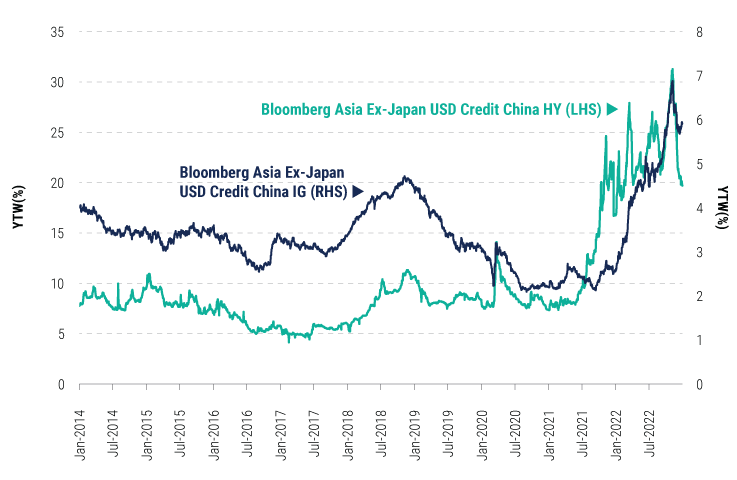
Source: Bloomberg as of 31 December 2022. For illustrative purposes only. We are not soliciting or recommending any action based on this material. Any opinions, projections, forecasts, or forward-looking statements presented are valid only as of the date indicated and are subject to change.
Beijing’s Policy Pivots: A Decisive End to Zero-Covid Plus Broad Property Sector Support
After three years of stringent zero-Covid measures, China officially downgraded its control over Covid-19 from Category A to the less restrictive Category B, effective from 8 January 2023. In short, quarantine for inbound travelers has been removed and outbound travel will gradually resume.
In the near term, the waves of infections in different regions of the country will affect consumer sentiment and disrupt supply chains. This risk is particularly high in the first two months of the year as the Chinese New Year holiday ushers in the world’s largest annual human migration. We expect economic data and corporate earnings in the last quarter of 2022 and the first quarter of 2023 to be depressed.
However, looking beyond this disruptive and bumpy reopening period, we expect economic activities to gradually recover from the latter part of the second quarter onward, on the back of pent-up demand. Specifically, Chinese households have accumulated decent excess savings during the pandemic years (estimated to be between CNY5 trillion and CNY10 trillion, or 4.25%-8.5% of GDP) as they cut spending and mortgage exposure (see the chart below).
Based on this, we expect:
Stronger household balance sheets to boost demand in various sectors and spur national retail sales to double-digit growth in 2023 (versus an estimated decline of 0.5% in 2022);
High-quality corporates to withstand the bumpy ride and reap the benefits of the expected recovery; and
Monetary and fiscal policies to remain accommodative to cushion the downside risks
China’s Households Have Accumulated Sizable Savings in the Pandemic Years
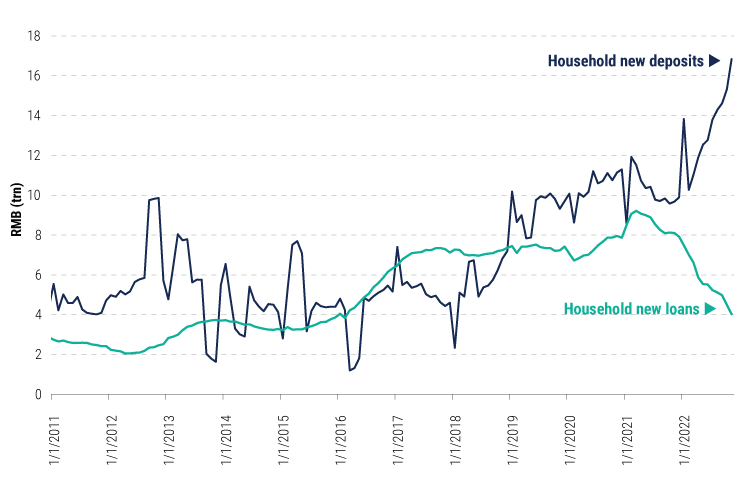
Source: Macrobond and PineBridge as of 1 November 2022. For illustrative purposes only. We are not soliciting or recommending any action based on this material. Any opinions, projections, forecasts, or forward-looking statements presented are valid only as of the date indicated and are subject to change.
China Retail Sales Suppressed by Covid Controls Should Start to Recover in 2023
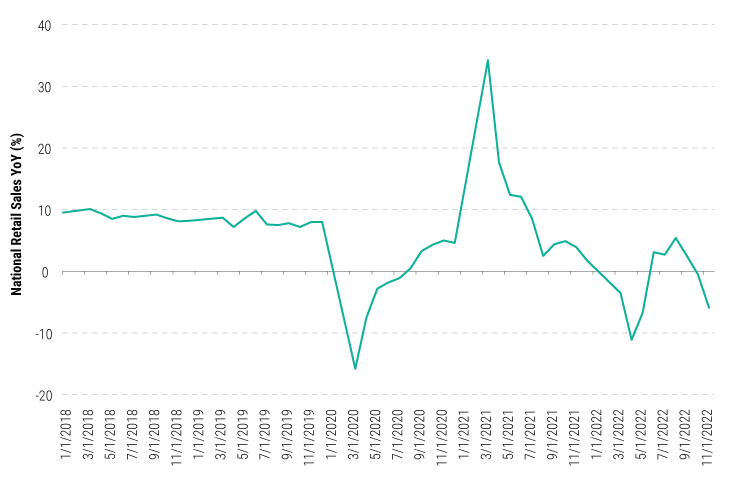
Source: Macrobond and PineBridge as of 30 November 2022. For illustrative purposes only. We are not soliciting or recommending any action based on this material. Any opinions, projections, forecasts, or forward-looking statements presented are valid only as of the date indicated and are subject to change.
While the Covid policy pivot provides upside momentum for growth from the second half of 2023 on, the turnabout in property sector policy reduces a significant downside tail risk for the economy.
Even after waves of defaults among major property developers and a plunge in nationwide property sales (down 42% year-on-year for 2022 for the top 100 developers, according to CRIC stats), the ailing property market will remain under pressure over the next few months as Covid outbreaks disrupt economic activities. However, the November 2022 announcement of comprehensive supportive financing policies will help ease liquidity pressures on the remaining high-quality developers. The 16 supportive measures cover major financial channels, and concrete follow-up actions have been taken, including new issuances in the domestic bond market and sizable credit lines granted to select developers. We also expect more demand-side policy relaxation (on home purchase restrictions and down-payment requirements, for example) to help stabilize the physical property market.
We are forecasting an L-shaped trajectory for property sales, as we interpret the policy objective as intended to stabilize the market (i.e., containing downside risks) rather than to engineer a sharp recovery, as in the previous cycle. Annual national residential property sales could be 30%-40% lower than the peak level going forward. Nonetheless, this is a more than US$1.5 trillion market in terms of annual sales, and high-quality developers should still play a role, albeit in much smaller numbers than before.
As Near-Term Sales Stagnate, Supportive Policies Augur for an L-shaped Trajectory
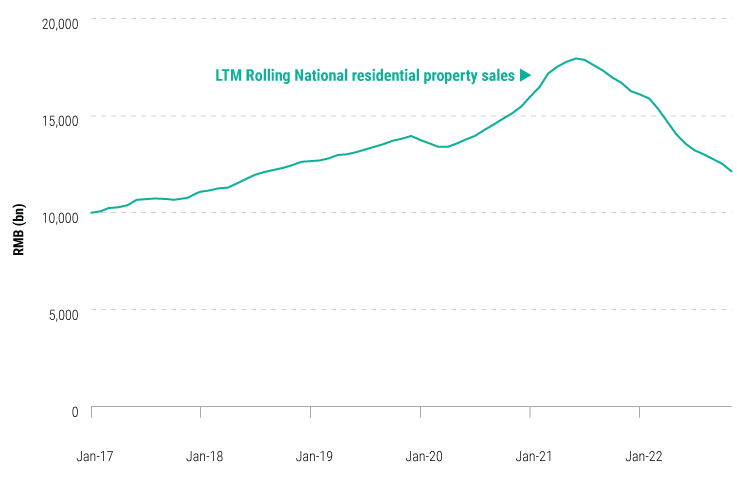
Source: Citi, NBS, and PineBridge as of 30 November 2022. For illustrative purposes only. We are not soliciting or recommending any action based on this material. Any opinions, projections, forecasts, or forward-looking statements presented are valid only as of the date indicated and are subject to change.
Annual National Sales Have Peaked, But Urbanization Supports Demand
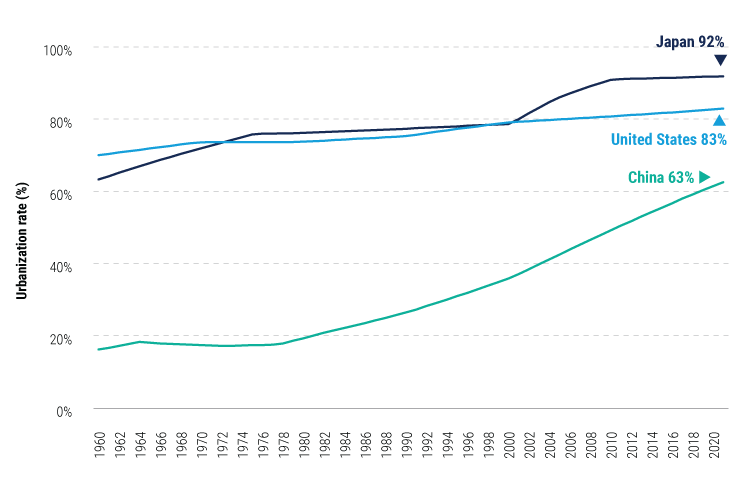
Source: World Bank and PineBridge as of 4 October 2022. For illustrative purposes only. We are not soliciting or recommending any action based on this material. Any opinions, projections, forecasts, or forward-looking statements presented are valid only as of the date indicated and are subject to change.
Policy Objectives Align With a Solid Credit Story – Despite Long-Term Challenges
We are optimistic about a reopening-driven growth rebound in China from the second half of 2023 and into 2024. However, we also acknowledge uncertainties associated with the country’s long-term growth trajectory amid unfavorable demographic trends, potential increases in state control, and ongoing US-China tensions.
That being said, we view policymakers’ major long-term objectives – of reducing systemic risk, enhancing the quality of economic growth, and maintaining social stability – as credit positive.
These shifts are already reflected in several key policy campaigns in recent years. These include a deleveraging campaign to improve the balance sheets of major state-owned enterprises (SOEs), regulatory tightening to reduce the size of the shadow banking sector (and hence systemic risk), and supply-side reforms to enhance capacity utilization and profitability in key industrial sectors. After short-term drags on growth when these initiatives were first introduced, the upshot from a credit perspective is that China is now generally better positioned than it was a few years ago, especially among the higher-quality credits.
Major SOEs Improved Their Balance Sheets Amid China’s Deleveraging Campaign
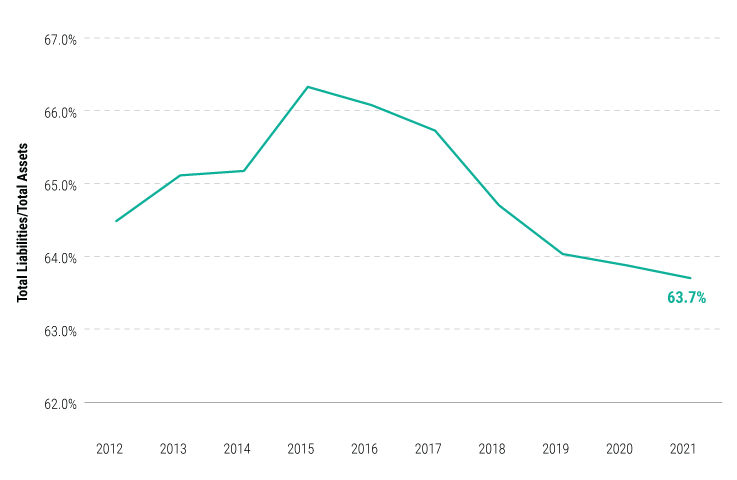
Shadow Banking Shrunk to 18% in Third-Quarter 2022 from 25% in January 2017
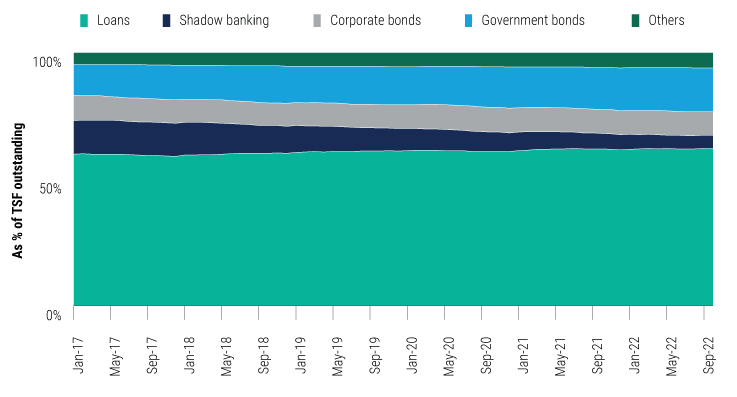
Supply-Side Reform Has Improved Industrial Utilization
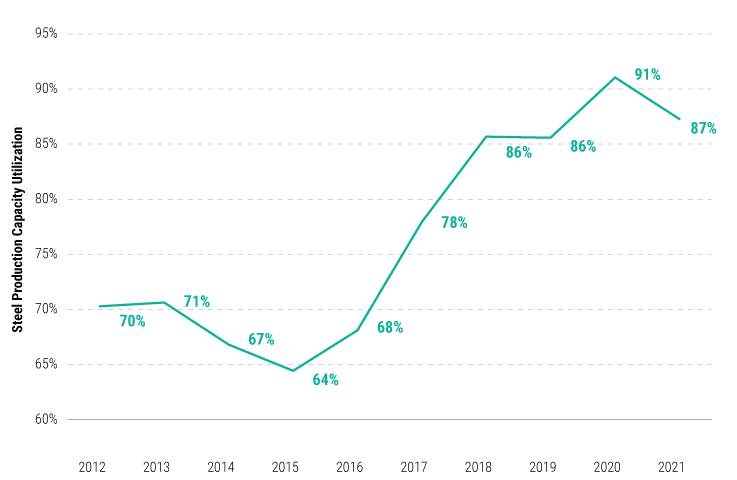
Source: Ministry of Finance, WIND, Bloomberg, PBoC, Morgan Stanley, and PineBridge Investments as of 30 October 2022. For illustrative purposes only. We are not soliciting or recommending any action based on this material. Any opinions, projections, forecasts, or forward-looking statements presented are valid only as of the date indicated and are subject to change.
Making Careful Credit Choices
We think three themes are likely to shape credit opportunities in China in 2023. First, the extent to which domestic companies can benefit from monetary policy easing; second, which firms survive the bailout of the property sector; and third, who benefits from the eventual reopening of the economy, however bumpy it might be.
China is one of the few major economies currently easing monetary policy. This means higher-quality issuers face an exceptional situation compared with corporates in other major markets: Average funding costs continue to decline due to the supportive onshore funding environment. By comparison, offshore investment-grade (IG) US dollar bonds are currently yielding more than 200 basis points more than IG onshore bonds.
This has been positive for credit fundamentals as well as demand/supply technicals of offshore US dollar bonds. Certain segments, including bank senior bonds and A rated SOE bonds, have outperformed in the past year on the back of this trend. We think over time this will extend to more credits that can benefit from the cheaper onshore funding, such as BBB rated SOEs and select high-quality privately owned enterprises (POEs).
Offshore China IG vs. Onshore AAA Yields
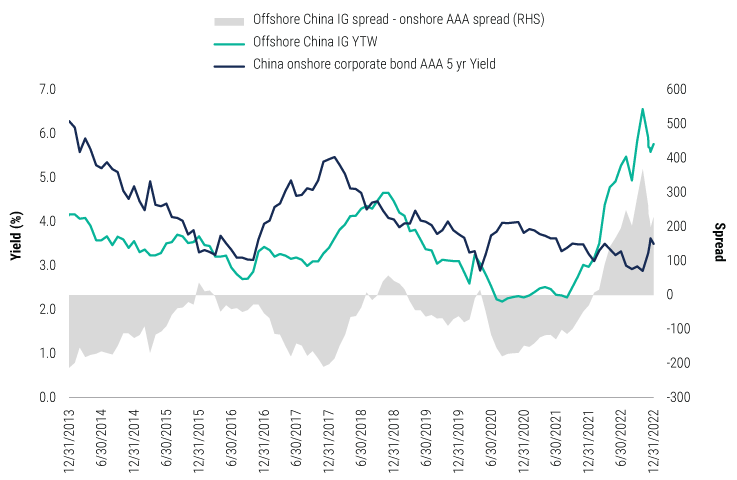
Offshore China HY (ex Property) vs. Onshore AA Yields
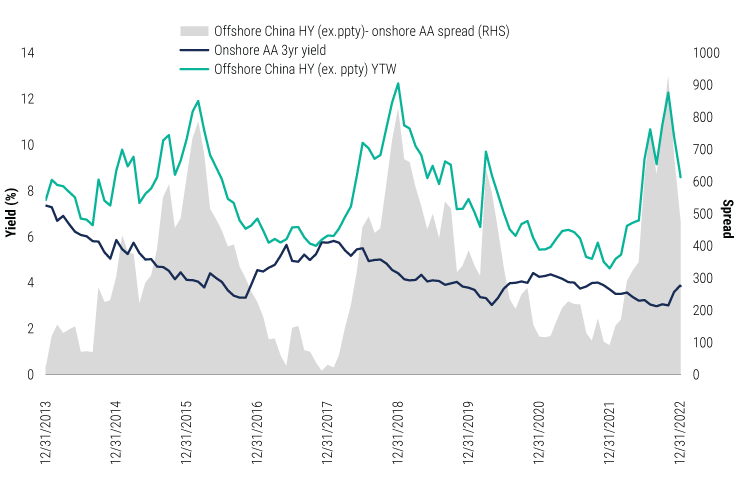
Source: Bloomberg, WIND, and PineBridge Investments as of 3 January 2023. For illustrative purposes only. We are not soliciting or recommending any action based on this material. Any opinions, projections, forecasts, or forward-looking statements presented are valid only as of the date indicated and are subject to change.
For the property sector, based on our assumption of an L-shaped trajectory for physical property sales, we expect to see further defaults among the weakest names, with the higher-quality companies surviving. Developers that can generate breakeven or positive operating cash flow in the current environment, or which have a large investment property portfolio, should prove more resilient. The fate of a number of borderline cases will hinge on the execution of supportive policy and the companies’ sales progress, and active investors will need to continually reassess these cases in the coming months.
More broadly, as China reopens, different sectors will benefit at different times, requiring investors to be selective in picking credits and entry points. This puts a spotlight on companies with adequate financial buffers to withstand this period before eventually benefiting as the economy rebounds. We think the consumer and retail sectors in particular, which have been hit hard by Covid lockdowns, offer pockets of opportunity. Within Greater China, select issuers in Hong Kong and Macau are also set to benefit as both cities reopen to mainland China and the rest of the world.
Hong Kong’s Economy, Particularly Retail, Is Set to Benefit From a Recovery in Tourism
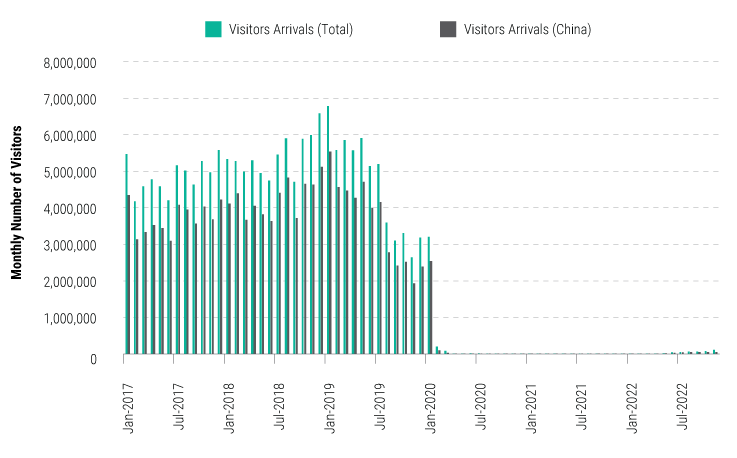
Macau Gross Gaming Revenue Is Expected to Recover From Depressed Levels
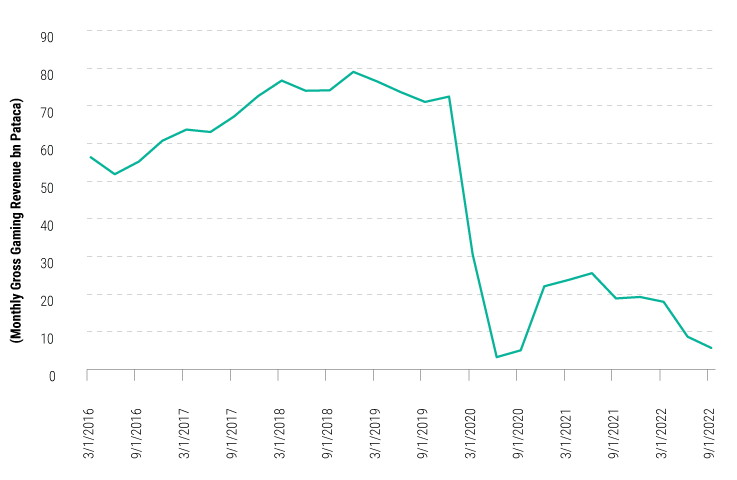
Source: Bloomberg and PineBridge as of 30 November 2022. For illustrative purposes only. We are not soliciting or recommending any action based on this material. Any opinions, projections, forecasts, or forward-looking statements presented are valid only as of the date indicated and are subject to change.
China Credits in Focus
Areas to watch for opportunities
BBB rated central government-owned financial and non-financial SOEs, where we see scope for spread compression against higher-rated SOEs.
Select private enterprises in the technology, media, and telecom (TMT) and consumer sectors, which are pricing in excessive rating risks and will likely benefit from China’s eventual reopening and policy easing.
Property developers with adequate liquidity, which are therefore set to benefit from ongoing policy support.
Areas with unfavorable risk/reward
Stressed credits in the property sector, where policy support has come too late.
The hardware tech sector, which is subject to US sanction risks.
Local government financing vehicles (LGFVs), which face fundamental pressure and don’t offer sufficient spread to compensate for the potential risks. While defaults remain minimal, policymakers can become more tolerant of defaults once the economy stabilizes.
Disclosure
Investing involves risk, including possible loss of principal. The information presented herein is for illustrative purposes only and should not be considered reflective of any particular security, strategy, or investment product. It represents a general assessment of the markets at a specific time and is not a guarantee of future performance results or market movement. This material does not constitute investment, financial, legal, tax, or other advice; investment research or a product of any research department; an offer to sell, or the solicitation of an offer to purchase any security or interest in a fund; or a recommendation for any investment product or strategy. PineBridge Investments is not soliciting or recommending any action based on information in this document. Any opinions, projections, or forward-looking statements expressed herein are solely those of the author, may differ from the views or opinions expressed by other areas of PineBridge Investments, and are only for general informational purposes as of the date indicated. Views may be based on third-party data that has not been independently verified. PineBridge Investments does not approve of or endorse any republication of this material. You are solely responsible for deciding whether any investment product or strategy is appropriate for you based upon your investment goals, financial situation and tolerance for risk.




